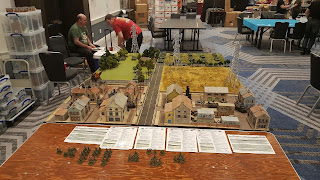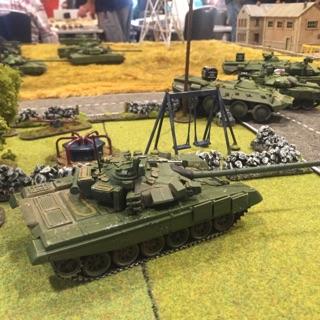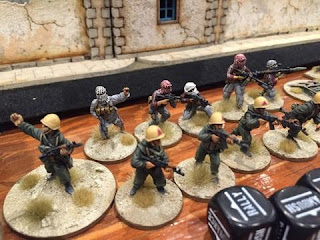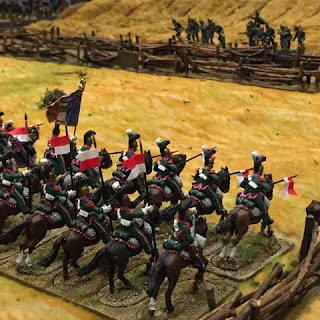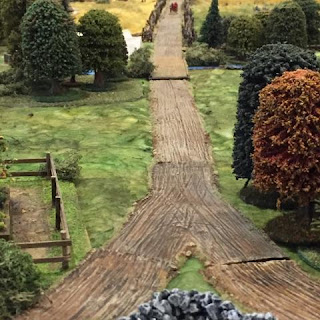Just a quick update today. I've received shipping confirmation from Full Battle Rattle Miniatures that my modern Canadian infantry platoon has shipped out to me!! Very excited to bring the Canadian Army to the tabletop. This was what I was waiting for to put in the "final push" to get all the vehicles done.
I expect to have the Canadians fighting in the modern European theater by November, if not sooner. This will round out my plan to build Russians, French, and Canadians. Roy Scaife is doing USMC, British, and Russian airborne forces - which covers all the bases except for the Germans. I know Empress Miniatures is working on modern Germans to add to their already large and excellent line of miniatures, so when they eventually get released those will get added into the mix as well.
For anyone looking at modern Canadians, head over to Full Battle Rattle Miniatures and gets yours now before they sell out!
Thursday, September 15, 2016
Tuesday, September 13, 2016
Rethinking Napoleonics
The recent game of Sharpe's Practice at Pacificon got my creative juices flowing for Napoleonic's again. My group has been happy with our adaptation of rules that combine Black Powder, Kings of War, and some house rules together, but ... there are still fundamental issues I have with Napoleonic wargaming in 28mm. The good news is I have a way forward and I've excited to play test out some significant modifications to the "Empires at War" rules. In fact, if all goes well, I'd say there will be little remaining in common with either Black Powder or Kings of War.
Of course, for a rules set it is all about generalization and/or the 80/20 rule. There are always exceptions to the rule of thumb, especially for a conflict that ran as long, and spanned as many armies and battles, as the Napoleonic Wars. That being said, in general you would see small amounts of cavalry attached to brigades or divisions, with significant formations of cavalry being deployed to a flank position or - perhaps most commonly, in a reserve position behind the main line to react to enemy breakthroughs or to exploit opportunities. With that in mind, my thinking here is to do the following:
First, I've decided to shift my collection to a 1:20 (or so) figure scale. This means I'll use 36 figure battalions for the French (for example). I've seen many use this figure ratio and unit size, but they base the figures normally 3 wide by 2 deep. I've decided instead to use the three rank system, and base each "company" 2 wide and 3 deep. Pictures below of what I mean ...
Anyways, that occupied my thinking this past week ... and my first unit to get converted over is some relatively new miniatures from Perry Miniatures that I needed to base anyways.
In other news, I've submitted a large order to Perry Miniatures for a Russian army, and for lots of casualties and battlefield extras (wagons, ambulance, etc.). I'm also going to finally wrap up the last touches on my Austrian army (which is rather large) --- which is significant as those units are going from 24 figures to 48!
Cavalry and Charges
One of the most overlooked and mistreated aspects of Napoleonic wargaming, in my opinion of course, is cavalry. I've seen all sorts of mistreatment - from a cavalry action on one flank that is essentially a game unto itself, until one side late in the game squeaks out an advantage (which may be pointless), to cavalry mixed in among infantry that forms square and shoots the cavalry to pieces, to cavalry charging into a unit, destroying it then sitting there doing nothing while getting blown away. So ... what to do about all this?Of course, for a rules set it is all about generalization and/or the 80/20 rule. There are always exceptions to the rule of thumb, especially for a conflict that ran as long, and spanned as many armies and battles, as the Napoleonic Wars. That being said, in general you would see small amounts of cavalry attached to brigades or divisions, with significant formations of cavalry being deployed to a flank position or - perhaps most commonly, in a reserve position behind the main line to react to enemy breakthroughs or to exploit opportunities. With that in mind, my thinking here is to do the following:
- "Full" cavalry formations are not deployed initially on the tabletop (unless there is significant space in the "rear area" of the table, but that is unlikely if you are playing 28mm. Instead, they arrive later in the game. Army commanders will roll a number of dice per turn. Commander qualities will apply but be simple/straight forward ... either a command is poor, average, or good. Let's say a command gets three dice (regardless of quality). At the start of a turn, the commander rolls those three dice. If the command is poor, they must discard results of 1, 2, or 3. Average discard results of 1 or 2 and good commanders discard results of 1. The remaining dice can be used for a few different things (and can be saved across turns, with a limit of 3 being saved and rolled over into the next turn). It takes 4 of these command dice to call a reserve brigade (not just of cavalry, but any formation) onto the table in the "center" of the table (divide your side of the table into three sections, left, center, and right). 5 of these dice allow you to shift the entry point to either the left or right thirds. An opponent on any turn following the entry of a reserve brigade, may use 4 dice to bring their brigade onto the table in the opposite sector (not additional dice required) - this representing the opposing formations reacting (if able given the number of dice) to the commitment of reserves. I'll stop there, but that should paint a general picture of my intention to have cavalry act more like a reserve reaction/exploitation formation. Cavalry units attached to infantry brigades would deploy normally with their brigades ... these rules would govern any reserve brigade, not just cavalry, but dedicated cavalry brigades would always start in reserve (unless specified differently by a scenario).
The second consideration I had was charges. Loosing an entire cavalry brigade or division was career ending, potentially army ending, and certainly made headlines at the time. As a result, many commanders were hesitant to commit cavalry unless desperate or confident of the outcome. Lots of cavalry charges can be found throughout many battles, but commonly when a cavalry unit charged they would go as hard and far as they could ... then they'd be out of the battle ... if not permanently, at least for a significant amount of time while they reformed. My thought here is:
- Makes charges an "all or nothing" thing. First, for cavalry specifically, rather than charging they can declare a "threatening" charge against an infantry formation (which burns their order/activation). The cavalry unit does not move but the infantry unit is required to form square (of course, the cavalry have to be able to charge the unit following the normal rules).
- For charges that do happen, use breakthroughs and fight melee normally, with victorious units either being required to declare another charge immediately following a victorious charge, or finishing their action "for the day." Once the fighting is done and the unit has "gone the distance" - the unit must either consolidate on the position or withdraw, but either way, that unit is no longer capable of charging for the rest of the game. This represents the big charge/push followed but such a level of disorganization and need for reforming that the unit is not destroyed, but other than defending itself, as spent itself for the portion of the battle being fought in the game.
Clearly all this needs to be play tested ... but hopefully the intention is clear. Units didn't bounce around constantly in good order charging everything that moved or looked at them funny. A charge was a big deal, and when done, was usually the end of the unit for many hours if not an entire day or battle (depending on the number of casualties sustained).
Ranks
The part of this is ranks. Now, again, rule of thumb. With so many armies and constant reorganizations occurring throughout the war, there is always an exception. That being said, in general we can say that the British used the 2 rank system (ok, you can argue there was an incomplete third rank in some cases being used to replace casualties, but the primary formation was a 2 rank system). Most everyone else used the trusty old 3 rank system. Although this is a well known fact about Napoleonic formations, I've never seen this employed on the tabletop.First, I've decided to shift my collection to a 1:20 (or so) figure scale. This means I'll use 36 figure battalions for the French (for example). I've seen many use this figure ratio and unit size, but they base the figures normally 3 wide by 2 deep. I've decided instead to use the three rank system, and base each "company" 2 wide and 3 deep. Pictures below of what I mean ...
 |
| Line formation. |
 |
| Line formation. |
 |
| Attack column. |
 |
| Attack column. |
Anyways, that occupied my thinking this past week ... and my first unit to get converted over is some relatively new miniatures from Perry Miniatures that I needed to base anyways.
In other news, I've submitted a large order to Perry Miniatures for a Russian army, and for lots of casualties and battlefield extras (wagons, ambulance, etc.). I'm also going to finally wrap up the last touches on my Austrian army (which is rather large) --- which is significant as those units are going from 24 figures to 48!
Monday, September 5, 2016
Pacificon Game Expo 2016 Convention Report
Well, another convention completed. I was really looking forward to this with all the work I crammed into the last couple of weeks to prepare. I played/ran several games and had a blast. The miniatures room was extremely busy all weekend, which is great to see.
Before jumping into the many pictures I took, I did take a short video while I was playing in a Sharpe's Practice game. It pans around the room and you can see it is busy - even though this was during Saturday afternoon, this was representative of Friday, Saturday, and Sunday. I'd even argue that Sunday was the busiest.
Before jumping into the many pictures I took, I did take a short video while I was playing in a Sharpe's Practice game. It pans around the room and you can see it is busy - even though this was during Saturday afternoon, this was representative of Friday, Saturday, and Sunday. I'd even argue that Sunday was the busiest.
Russia Resurgent
This game was based around a small French forces positioned at the edge of a French town on the border. The Russians managed to break through the Fulda Gap and pushed to the French border before the NATO nations could get reinforcements into the European theater of operations. The Russia orders where simple, use superior numbers and rapid advance to overwhelm the enemy forces - or suffer the ill report of the political officer! The French had to hold the town and slow down the Russians as much as they could.
You can see all sorts of new stuff I did for this table: high tension electrical power lines, new trees/bases, paved roads, French armour, playground (needs more work), and more!
Downtown Baghdad
This scenario was different from what I've been running for Operation Iraqi Freedom. A senior Iraqi official for the newly created provisional Iraqi government is attending a "hearts and minds" event - trying to make things look like they are getting better. The press and many civilians are in a small park/square with a mixed USMC and British Army contingent providing a security perimeter. The former Iraqi army and insurgents have planned to start their insurgency by capturing the Iraqi VIP so he can be executed in a video for propaganda. The coalition forces must evacuate the VIP to safety if the situation becomes too dangerous.
The primary egress route was compromised by an IED, so the VIP had to be evacuated through the secondary route. The coalition suffered several casualties, including losing a Warrior IFV, but managed to pull off a minor victory.
The primary egress route was compromised by an IED, so the VIP had to be evacuated through the secondary route. The coalition suffered several casualties, including losing a Warrior IFV, but managed to pull off a minor victory.
Sharpe's Practice
This game was put on by the famous Adam Clark (http://adam-clark.com). I played as one of three French players, running the left flank with Dragoons, Lancers, and a small Grenadier unit. My flank saw a lot of action early, with my Lancers jumping out early to route the British Hussars, but then being shot into oblivion by British infantry and riflemen. The battle then shifted to the other sectors, with the final action taking part in the center. British victory.
WW2 Late War (Bolt Action)
Roy Scaife ran a great game for Bolt Action WW2. This was late war, with the US forces advancing into Germany and facing mixed German resistance. The US pushed hard but in the end the Germans managed to push them off for the day. The US, pushed back by superior armour, fell back and called in the air corps. I was a bonehead on this one and completely forgot to take lots of pictures, so I only and a small number (also, my phone was charging at the time).
54mm Wooden Wars Imaginations
The awesomely creative Thomas Foss (http://skullandcrown.blogspot.com) ran his 54mm Imagination game (essentially WSS). Every single miniature in this game, and game aid, is laser cut. It is a truly unique game, plays easy and fast, and is very fun. I played a brigade on the left flank, helping defend a city. I was rolling hot (using someone else's dice, not mine!) and managed to roll the advancing flank opposite me. Had a blast - as is guaranteed at a game Thomas is running.
Other Games
Below is an assortment of some others games I took pictures of - two key ones being an impressively large and outstandingly painted Wargods game - using the Clash of Iron rules. Another great game was Alamo - which you can see below and in the video at the top of this post.
Well, that is about it ... also played lots of board games. I hope you enjoyed all the pictures. Now I can get back to some regular projects and get more gaming happening!
Subscribe to:
Posts (Atom)




